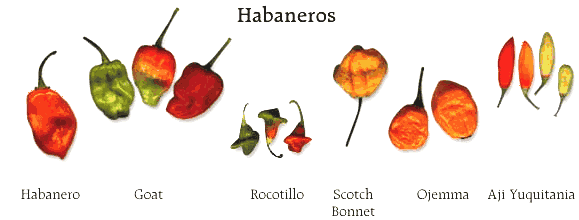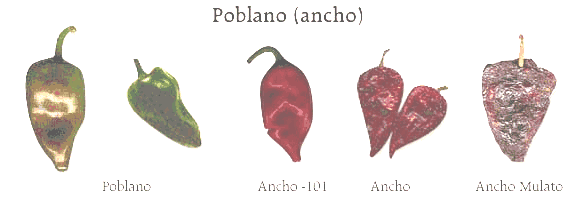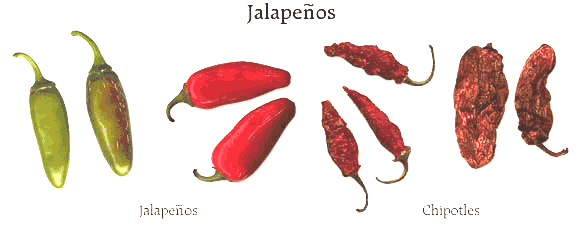Mexican Kitchen
Perhaps no other single ingredient has had such a dramatic upsurge in mainstream culinary use over the last decade as has chile (chee-lay). Once considered an exotic component of Latin, Indian and Asian cuisines, the chile, in its many fresh and dried forms, has become a modern kitchen staple, added to everything from salad dressings to pasta dishes.
The omnipresent ingredient in the diet of the ancient Mesoamericans has finally become part of our own culinary landscape.
Chile is the name generally given to all fruit of capsicum plants, New World natives of Mexico, Central and South America and the West Indies. A wild variety of capsicum has been found in anthropological sites in the Tehuacan valley, in south central Mexico, dating from 7200 to 5200 B.C. Capsicum annuum, the variety found in these sites, is the species that provides nearly all of the chiles known and cultivated today, a group which encompasses an impressive array of colors, shapes, sizes and degrees of “heat.”
This “heat” is caused by capsaicin, a substance produced by glands in the seed-bearing part of the chile. The Scoville test, invented in 1912 and based on a tasting consensus, attempted to measure the pungency of chiles, and modern high-pressure liquid chromatography has attempted the same thing, but any good Mexican home cook knows that there are only a few ways to control the heat in chiles. Removing the seed sac and seeds is the most logical, and soaking in a vinegar or salt water solution is another.
These preventative measures are often required to avoid the irritating effects on the mouth, tongue, eyes and hands that capsicum can produce. The ancient inhabitants of Mexico knew about these effects and cleverly used chiles as an early means of chemical warfare, discipline and fumigation.
However, not all chiles are hot, as noted in the two-part guide presented here, which covers over thirty different kinds of Mexican chiles, fresh and dried, hot and mild. Although the chile spread to all parts of the world, gaining particular favor in Asia, the guide contains chiles found specifically in Mexico and used in Mexican cooking. This month is devoted to fresh chiles and recipes using them. Look for Part II, Dried Chiles, next month.

Fresh Chiles:
- Chilaca:
- a long (approximately 5″) mild to medium-hot, deep green chile, used most frequently in Western Mexico, especially in the state of Jalisco, for fresh salsas and rajas- marinated or sautéed chile strips- and known in its dried state as pasilla.
- Chile de agua:
- 4″-5″ long, hot, bright yellow-green chile, found in Southern Mexico, most often in Oaxaca, and used there for making a very piquant version of chiles rellenos.
- Chile largo:
- a yellow-green variety of jalapeno, approximately 3″ long, medium-hot, frequently pickled- en escabeche- and used as a condiment.
- Cuaresmeño:
- a large (3″-4″), mild jalapeño, often used for stuffing with cheese, tuna and other meatless fillings, and thus named after Lent, Cuaresma.
- Güero:
- a hot, triangular-shaped, 2″-3″ long chile, used as a condiment, its name means “blonde” because of its yellow color.
- Habanero:
- said to be the hottest chile in Mexico, this small (about 2″ long and 1″ wide) yellow-orange to bright orange chile is a characteristic ingredient of the cuisine of the Yucatan, where it is used to make table salsas.
- Huachinango:
- a 3″-4″ long thick-skinned, hot variety of jalapeño, it may be pickled, stuffed, or both, and frequently served as a botana – cocktail snack or hors d’ouevre.
- Jalapeño:
- one of the most famous and widely-used chiles, both in and outside of Mexico, this deep green chile averages approximately 3″ long and is used both fresh and pickled in a wide variety of dishes ranging from salsas to stuffed jalapeños. Fresh jalapeños are frequently canned in a pickling solution called escabeche.
- Manzano:
- so named because it is shaped just like a small (about 2″ sphere) apple, bright reddish-orange and hot, it is most frequently found in its dried form, known as a cascabel.
- Poblano:
- most famous as a stuffing chile, this large (about 5″ long) mild, dark green variety, originally cultivated in the state of Puebla, is also used to make chile strips, cream sauces, vegetables, chicken, fish and pasta dishes; dried, it is called an ancho.
- Poblano rojo:
- known as a “ripe” poblano, this late-summer chile develops a deep red color and hotter flavor than the mild green poblano, and is highly prized in the Puebla region for making the seasonal chiles en nogada.
- Serrano:
- a very small (only about 1½”- 2″ long and ¼”-1/2″ wide) bright-green chile, commonly found in even the most basic markets throughout Mexico, it is used in fresh and cooked salsas, as well as several mushroom and egg dishes.

Some Culinary Uses of Fresh Chiles
- ” Table Salsas: “
- Fresh chiles are required in most uncooked salsas, known as salsas frescas or salsas crudas. The most commonly used for these are jalapeños and serranos, finely chopped or ground with other uncooked ingredients such as tomatoes, onions and fresh herbs.
- ” Rajas:”
- Another common use for fresh chiles is in the making of rajas- thin strips of fresh chile, sometimes roasted and peeled, other times with the skin left on. The rajas may be sautéed with other ingredients such as strips of onion, tomatoes or nopales. Or they may be combined with cream or melted cheese to make a side dish or a sauce for pasta or vegetables. The most common chile for rajas is the poblano, although in Oaxaca, the more piquant chile de agua is frequently used.
- “Escabeche:”
- Fresh chiles are wonderful pickled, either alone or in combination with other vegetables. The classic combination of pickled jalapeños, onions, carrots and spices is so common that even the smallest village store carries it in cans, though the homemade versions are usually far superior. Chile largo is often pickled and served as a condiment, as are güero and habanero.
- “Chiles rellenos:“
- Poblanos, jalapeños, cuaresmeños, huachinangos and chiles de agua are all suitable for stuffing with a wide variety of meat, cheese, mushroom, chicken, seafood and bean fillings. They may be fried, cooked in sauce, baked or marinated.
Some Recipes . . .
- Rajas con Crema: Fresh Chile Strips in Cream Sauce
- Chiles en Escabeche: Pickled Fresh Chiles with Vegetables


